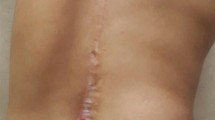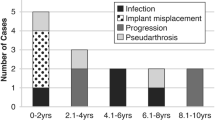Abstract
Study Design
Multi-center retrospective review.
Objective
The purpose of this study was to identify preoperative variables associated with postoperative complications in early-onset scoliosis (EOS) patients treated with traditional growing rods (TGR); and to develop a model to predict the incidence of postoperative complications based on preoperative variables.
Summary of Background Data
TGRs are commonly used to treat progressive EOS. Prior research has demonstrated a high rate of postoperative complications using this technique; however, few studies have identified preoperative factors that contribute to such complications.
Methods
A total of 110 patients who initiated TGR treatment before 10 years of age and completed final treatment were identified from a multi-center database. Overall treatment effect was calculated for major curve size, thoracic kyphosis, thoracic height, and total spine height. Univariable and multivariable logistic regression identified preoperative predictors of complications. An algorithm was developed and validated to calculate the probability of complications based on preoperative data.
Results
All patients completed TGR treatment (average follow-up 8.1 years). The overall treatment effect was a significant decrease in major curve magnitude, increase in thoracic height, increase in spine height, and no significant change in thoracic kyphosis. There were 263 total complications in 87 patients (79%) resulting in 84 unplanned surgeries. The most common complications were implant-related (49%), surgical site infection (23%), medical (19%), alignment (6%), and neurologic (3%). The significant independent preoperative predictors of complications were age at implantation and preoperative thoracic kyphosis. Multivariable regression showed that age less than 7.6 years, thoracic kyphosis greater than 38 degrees, or major curve magnitude greater than 84 degrees significantly increased the probability of complications.
Conclusions
Earlier age at implantation, greater thoracic kyphosis, and larger major curves increased the probability of complications following TGR instrumentation. These findings provide a valuable tool for predicting complications that may aid in surgical planning and shared decision making with patients and their families.
Level of Evidence
IV.
Similar content being viewed by others
References
El-Hawary R, Akbarnia B. Early onset scoliosis—time for consensus. Spine Deform 2015;3:105–6.
Lloyd-Roberts GC, Pilcher MF. Structural idiopathic scoliosis in infancy: a study of natural history of 100 patients. J Bone Joint Surg Br 1965;47:520–3.
Phillips JH, Knapp Jr DR, Herra-Soto J. Mortality and morbidity in early-onset scoliosis surgery. Spine 2013;38:324–7.
Skaggs DL, Akbarnia BA, Flynn J, et al. Classification of treatment of early-onset scoliosis. Paper presented at: 2nd International Congress of Early Onset Scoliosis and Growing Spine; November 7–8, 2008; Montreal, Quebec, Canada.
Kamachi S, Demirkiran G, Ismavilov V, et al. The effect of dual growing rod instrumentation on the apical vertebral rotation in early-onset idiopathic scoliosis. J Pediatr Orthop 2014;34:607–12.
Thompson GH, Akbarnia BA, Campbell RM. Growing rod techniques in early-onset scoliosis. J Pediatr Orthop 2007;27:354–61.
Mineiro J, Weinstein SL. Subcutaneous rodding for progressive spinal curvatures: early results. J Pediatr Orthop 2002;22:290–5.
Akbarnia BA, Marks DS, Boachie-Adjei O, et al. Dual growing rod technique for the treatment of progressive early-onset scoliosis: a multicenter study. Spine 2005;30:S46–57.
Bess S, Akbarnia BA, Thompson GH, et al. Complications of growing-rod treatment for early-onset scoliosis: analysis of one hundred and forty patients. J Bone Joint Surg Am 2010;92:2533–43.
Karol LA. Commentary on an article by S. Bess, et al.: Complications of growing-rod treatment for Early-Onset Scoliosis. Analysis of one hundred and forty patients. J Bone Joint Surg Am 2010;92:e27.
Gillingham BL, Fan RA, Akbarnia BA. Early onset idiopathic scoliosis. J Am Acad Orthop Surg 2006;14:101–12.
Mehta MH. The rib-vertebra angle in the early diagnosis between resolving and progressive infantile scoliosis. J Bone Joint Surg Br 1972;54:230–43.
Jiang Y, Zhao Y, Wang YP, et al. Lung function after growing rod surgery for progressive early-onset scoliosis: a preliminary study. Chin Med J 2011;124:3858–63.
Newton PO, Faro FD, Gollogly S, et al. Results of preoperative pulmonary function testing of adolescents with idiopathic scoliosis. J Bone Joint Surg 2005;87:1937–46.
Sankar WN, Skaggs DL, Yazici M, et al. Lengthening of dual growing rods and the law of diminishing returns. Spine 2011;36:806–9.
Watanabe K, Uno K, Suzuki T, et al. Risk factors for complications associated with growing-rod surgery for early-onset scoliosis. Spine 2013;38:E464–8.
Schroerlucke SR, Akbarnia BA, Pawelek JB; Growing Spine Study Group. How does thoracic kyphosis affect patient outcomes in growing rod surgery? Spine 2012;37:1303–9.
Dannawi Z, Altaf F, Harshavardana NS, et al. Early results of a remotely-operated magnetic growing rod in early-onset scoliosis. Bone Joint J 2013;95B:75–80.
Akbarnia BA, Cheung K, Noordeen H, et al. Next generation of growth-sparing techniques: preliminary clinical results of a magnetically controlled growing rod in 14 patients with early-onset scoliosis. Spine 2013;38:665–70.
Cheung KM, Cheung JP, Samartzis D, et al. Magnetically controlled growing rods for severe spinal curvature in young children: a prospective case series. Lancet 2012;379:1967–74.
Hickey BA, Towriss C, Baxter G, et al. Early experience of MAGEC magnetic growing rods in the treatment of early onset scoliosis. Eur Spine J 2014;23(suppl 1):S61–5.
Yoon WW, Sedra F, Shah S, et al. Improvement of pulmonary function in children with early-onset scoliosis using magnetic growth rods. Spine 2014;39:1196–202.
Rolton D, Richards J, Nnadi C. Magnetic controlled growth rods versus conventional growing rod systems in the treatment of early onset scoliosis: a cost comparison. Eur Spine J 2015;24:1457–61.
Corona J, Matsumoto H, Roye DP, Vitale MG. Measuring quality of life in children with early onset scoliosis: development and initial validation of the early onset scoliosis questionnaire. J Pediatr Orthop 2011;31:180–5.
Author information
Authors and Affiliations
Consortia
Corresponding author
Additional information
The Growing Spine Foundation (GSF) provided financial support for this study; however, no authors or institutions received financial compensation for this work. In addition, the GSF provided the research data for this study. The GSF receives donations from the study group’s surgeon members, medical device industry, grateful patients, and other donors.
Author disclosures
VVU (personal fees from OrthoPediatrics, grants from POSNA, outside the submitted work); KCP (none); JBP (none); PEM (none); GHT (personal fees from Shriner’s Hospital Medical Advisory Board, personal fees from Wolters Kluwer, other from OrthoPediatrics, outside the submitted work); DLS (nonfinancial support from Pediatric Orthopaedic Society of North America, nonfinancial support from Scoliosis Research Society, personal fees from Biomet, personal fees from Medtronic, personal fees from Zipline Medical, Inc., personal fees from Orthobullets, personal fees from Grand Rounds, grants from Pediatric Orthopaedic Society of North America, grants from Scoliosis Research Society, personal fees from Biomet, personal fees from Medtronic, personal fees from Johnson & Johnson, other from Wolters Kluwer Health–Lippincott Williams & Wilkins, other from Biomet Spine, other from Zipline Medical, Inc., outside the submitted work; in addition, DLS has a patent Medtronic issued, and a patent Biomet issued); JBE (other from journal Children’s Orthopedics, personal fees from Medtronics, personal fees from DePuy Synthes, other from DePuy Synthes, outside the submitted work); MPG (personal fees from Medtronic, personal fees from DePuy, other from Children’s Spine Study Group, outside the submitted work).
Ethical approval
All participating institutions obtained IRB approval prior to study initiation.
The medical devices mentioned in this paper have been cleared by the US Food and Drug Administration.
Rights and permissions
About this article
Cite this article
Upasani, V.V., Parvaresh, K.C., Pawelek, J.B. et al. Age at Initiation and Deformity Magnitude Influence Complication Rates of Surgical Treatment With Traditional Growing Rods in Early-Onset Scoliosis. Spine Deform 4, 344–350 (2016). https://doi.org/10.1016/j.jspd.2016.04.002
Received:
Revised:
Accepted:
Published:
Issue Date:
DOI: https://doi.org/10.1016/j.jspd.2016.04.002




